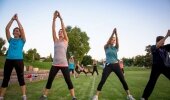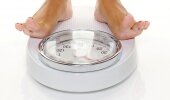Words: Lucy Le Roux
The saying “all things in moderation” also seems to apply to how much time we spend sitting down. Though sitting may seem harmless, research shows that if you have a desk job, you could have twice the risk of cardiovascular disease than people with jobs that require standing or moving around for most of the day.
Courtesy of: Sha-Izwe Communications/CharlesSmithAssoc
"Sitting," says Dr. James Levine, an endocrinologist at the Mayo Clinic who has researched the dangers of a sedentary life for the last 15 years, "is the new smoking." Levine's study has shown that sitting around, as many of us do for both work and pleasure, is bad for your health.
Research shows that sitting for periods of six hours or more each day can be detrimental, even if you go to gym twice a week. As soon as you sit, electrical activity in the leg muscles shuts off, calorie burning drops to 1 per minute and enzymes that help break down fat drop 90%. After two hours, good cholesterol drops 20% and after 24 hours insulin effectiveness drops 24%, raising the risk of diabetes. Sitting for hours at a time also diminishes the health of your blood vessels, increasing the risk of heart disease.
Though sitting has a negative cumulative effect on health over time, people who sit more than most, like extreme online gamers, have suffered short-term consequences. Several young adults globally have died after playing online computer games for multiple hours in a row.
One 18 year old in southern Taiwan collapsed and died after playing for 40 hours straight. Authorities speculated that long hours in a sedentary position created cardiovascular problems. In 2004, a 24-year-old died from a blood clot after an 80-hour gaming marathon, while in 2011, British 20-year-old Chris Staniforth died the same way after spending up to 12 hours a day on his Xbox.
Humans can go 11 days without sleep, 3-5 days without water and eight weeks without food, but continuous sitting can have a fatal effect in a shorter time span. The first associations between prolonged sitting and clots was in 1940 when a pathologist in London, Simpson, noticed an increased death rate due to pulmonary emboli from people sitting on deck chairs in bomb shelters during the blitz. Today with our increasingly sedentary lifestyles and time spent on computers, the problem is becoming so common that pulmonary emboli has beendubbed an ‘E-thrombosis’.
So just how much time are we spending sitting? A Lifeblood survey conducted by ComRes in 2012 targeted 1000 people - “workers” and “gamers”. They found that office workers spent an average of 2.75 hours at their desk without moving. The risk of embolisms increased for people who ate lunch at their desks.
Those working in law, finance or IT were more likely to eat at their desks (45%) and less likely to move around during the day (32%). When looking at gamers, the average gamer spends an average of three hours sitting before getting up and spends about five hours playing at a time. This is without considering the amount of time people spend sitting in traffic or in front of their TV’s once home.
People who have desk jobs should try to be active during and after working hours and should not sit for long periods, even at home. Here are a few tips for reducing the amount of time spent sitting:
- Try the Pomodoro Technique. It involves working in focused bursts of 25 minutes with five minute breaks. This not only gets you up and moving but aids in focus and productivity. You can download Focus Booster - a digital pomodoro for Windows. http://download.cnet.com/Focus-Booster/3000-2350_4-10971798.html
- Take the stairs and encourage able-bodied staff to take part is ‘Movement Monday’s’ where staff have to take the stairs, walk to get lunch outside the building, etc, to get the week off to a good start.
- Buy a FITBIT or the newly released Apple iWatch. This wearable technology has the capability to count how many steps you take each day andhelps you track your goals and progress in moving more throughout the day.
- Consider speaking to your manager about flexi-hours or working from home to reduce the amount of time spent sitting in traffic.
-Try not to sit down when you are away from your desk. If you are making a cup of coffee and there is place to sit and chat, stand and chat instead.
Office design can also positively contribute to staff sitting for shorter periods. Offices should be designed with separate areas for meeting, relaxing and making private phone calls to encourage movement throughout the day. This means putting shared resources in central areas that requires staff to walk to get coffee or fetch their printing. It encourages not just movement and also collaboration.
Make sure you have at least one meeting room with a high table and no chairs for standing meetings. Not only will these meetings be shorter and more focused, but you will also be more energised. Consider having phone booths so that people can take private calls and move while doing so, or having a fewheight adjustable desks in the office so that people can choose to go stand and work if they would like to. If you do spend a significant part of your day sitting then having a good ergonomic chair that you know how to use effectively.
General guidelines for correct sitting:
- Width of chair – The seat pan should be wide enough so it does not apply pressure to your thighs.
- Height of chair: The seat height should be adjusted so your feet rest firmly on the floor allowing you to take some weight through yourfeet when you are seated.
- Change position: sit back in your chair at 135° when taking phone calls or talking to colleagues rather than sitting at 90° (vertically) or leaning forward.
- Seat Tilt – Seat tilt can be adjusted to improve your comfort and your weight distribution. A small tilt of approximately five degrees sloping forward is usually recommended.
- Depth of Seat – When sitting, your thighs should be fully supported by the seat allowing you to use the back support without the front of the seat pressing against the backs of your knees
- Do foot and calf exercises while sitting to get blood moving in your legs and interrupt sitting wherever possible.
Overall, it is important to keep regular movement at the office and at home. We all need to sit, but try not to sit for long periods. In addition, try make minor changes to your current office design to encourage staff to movearound. And when designing a new office environment, create a design that encourages the movement of staff, but without creating disruptions.
Sources:
http://www.dailymail.co.uk/news/article-2175410/Teenager-dies-playing-ga...
http://www.thrombosis-charity.org.uk/perch/resources/e-thrombosis-march-...
http://www.nzherald.co.nz/lifestyle/news/article.cfm?c_id=6&objectid=111...
http://www.mindbodygreen.com/0-11907/why-sitting-is-killing-you-9-things...
http://education.qld.gov.au/health/pdfs/healthsafety/ergonomics-guide-20...












